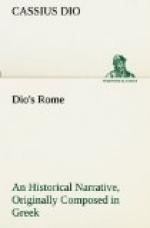After these ceremonies the triumphator ascended his chariot. Now the chariot did not resemble one used in games or in war, but had been made in the shape of a round tower. And he would not be alone in the chariot, but if he had children or relatives he would make the girls and the infant male children get up beside him in it and place those who were grown upon the horses, outriggers as well as the yoke-pair. If these were many, they would accompany the procession on chargers, riding along beside the triumphator. None of the rest rode, but all went on foot wearing laurel wreaths. A public servant, however, rode also upon the chariot itself holding over him the crown made of precious stones set in gold and kept saying to him “Look behind!”, the “behind” meaning naturally “Look ahead at the ensuing years of life, and do not be elated or puffed up by your present fortune.” Both a bell and a whip were fastened to the chariot, signifying that it was possible for him to meet misfortune as well, to the extent of being disgraced or condemned to death. It was customary for those who had been condemned to die for any offence to wear a bell, to the end that no one should approach them as they walked along and so be affected with pollution.
Thus arrayed they entered the city, having at the head of the procession the spoils and trophies and in images the captured forts displayed, cities and mountains and rivers, lakes, seas,—everything that they had taken. If one day sufficed for the exhibition of these things in procession, well and good: otherwise, the celebration was held during a second and a third. When these adjuncts had gone on their way the triumphator reached the Roman Forum and after commanding that some of the captives be led to prison and put to death he rode up to the Capitol. There, when he had fulfilled certain rites and had brought offerings and had dined in the buildings on the hill, toward evening he departed homeward, accompanied by flutes and pipes.
Such were the triumphs in old times. Factions and powerful cliques attempted very frequently revolutionary movements on those occasions.
All the matters pertaining to the triumphal, the curule chair the letter contains. What need to write again? How after anointing with cinnabar or else Sinopian earth the man who held a triumph they put him on a chariot and placed upon his head a golden crown bearing plainly marked all he had accomplished: in the man’s hand they lay a laurel sprig; armlets they clasp about his arms: they crown all who had gained distinction with crowns made out of silver material inscribed with the feats of daring; and how upon the chariot a public slave stands behind him holding up the crown and saying in his ear: “see also what comes after”—all things important the letter contains. (Tzetzes, Hist. 13, 41-54.)




